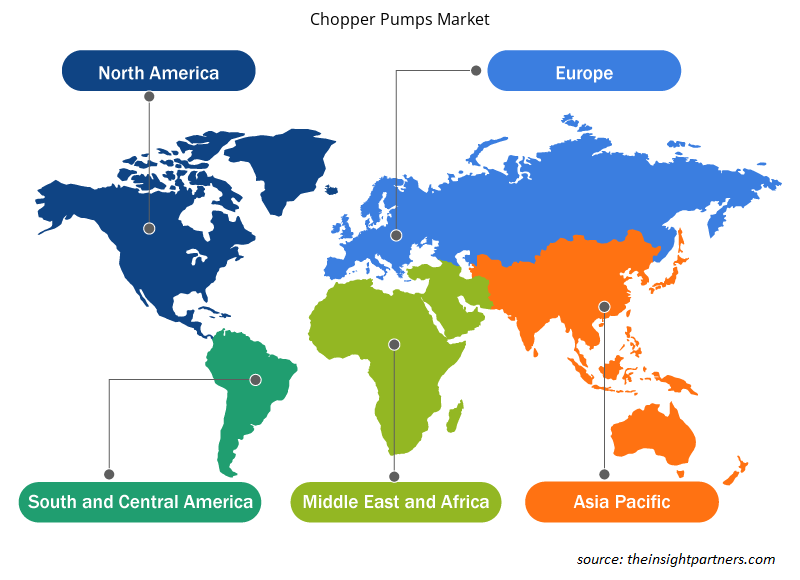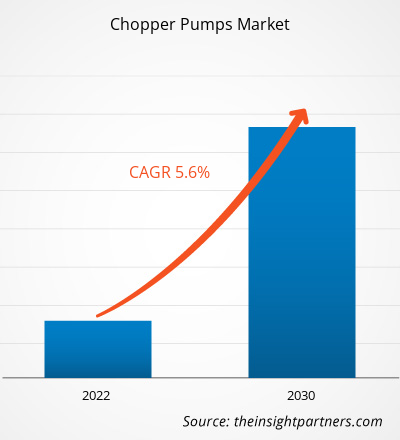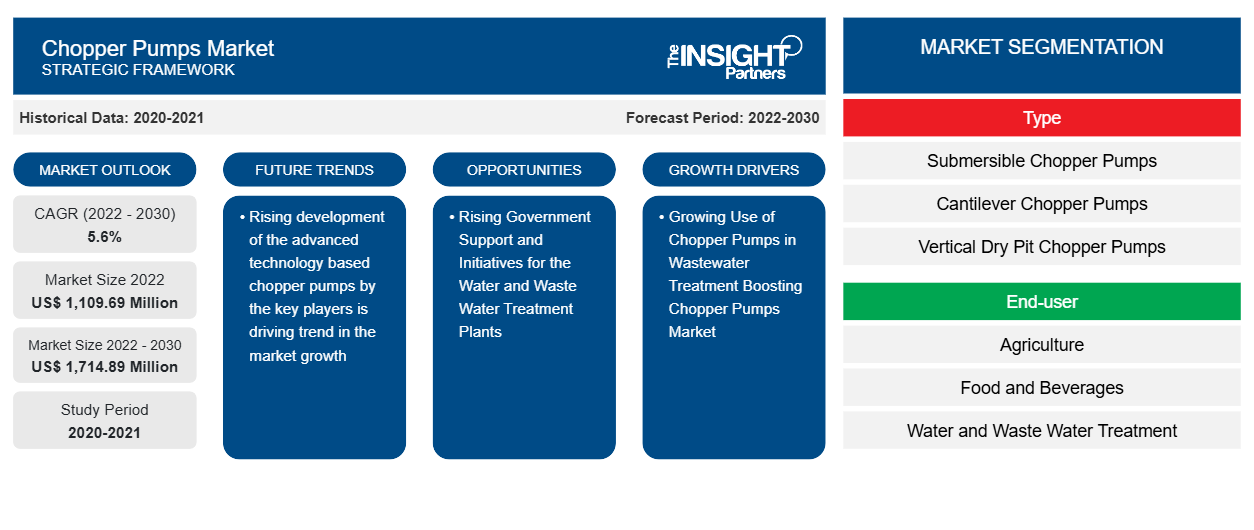Si prevede che le dimensioni del mercato delle pompe chopper raggiungeranno 1.714,89 milioni di $ entro il 2030 da 1.109,69 milioni di $ nel 2022. Si prevede che il mercato registrerà un CAGR del 5,6% nel 2022-2030. La domanda in forte crescita in diversi settori, tra cui il trattamento delle acque e delle acque reflue, alimenti e bevande e prodotti chimici, probabilmente guiderà la crescita del mercato globale delle pompe chopper durante il periodo di previsione. Le pompe chopper sono ampiamente utilizzate nell'estrazione di acque reflue da vari impianti nel settore alimentare e delle bevande e chimico. L'uso di pompe chopper sta aumentando a un ritmo rapido a causa della crescente domanda di acqua riciclata e della crescente scarsità di acqua. La crescente attenzione agli impianti di trattamento delle acque e delle acque reflue con iniziative e finanziamenti governativi guida la crescita del mercato delle pompe chopper.
La crescente domanda di manutenzione di linee fognarie adeguate per ridurre l'inquinamento ambientale sta portando all'applicazione di pompe trituratrici. Le pompe trituratrici hanno la capacità di gestire rifiuti solidi concentrati in vari settori industriali. La protezione ambientale e il crescente sostegno governativo per gli investimenti in impianti di trattamento delle acque reflue in paesi europei come Germania, Regno Unito, Francia e Italia sono i principali fattori trainanti per il mercato delle pompe trituratrici . Le pompe trituratrici sono progettate per pompare liquidi altamente contaminati con un elevato contenuto di secco. Queste pompe sono utilizzate in diversi settori verticali dell'industria di utilizzo finale come agricoltura, trattamento delle acque reflue, prodotti chimici, alimenti e bevande.
Analisi di mercato delle pompe chopper
Le pompe trituratrici hanno un'ampia gamma di applicazioni in settori quali il trattamento delle acque reflue, l'acquacoltura, la lavorazione alimentare, la bioenergia, la cellulosa e la carta e il petrolio e il gas. Le pompe trituratrici sono adatte per il pompaggio di rifiuti solidi, fanghi e grassi da questi settori, come menzionato sopra. Queste pompe trituratrici hanno un intervallo di pressione di esercizio fino a 6 bar. Quindi, sostituiscono la maggior parte degli altri tipi di pompe di spostamento.
Panoramica del mercato delle pompe trituratrici
Una pompa trituratrice non solo pompa i rifiuti solidi, ma mentre pompa, li sminuzza anche in pezzi molto più piccoli in modo che possano essere passati attraverso la pompa e non intasare le linee di scarico dalla pompa al punto terminale successivo. Le pompe trituratrici sono generalmente utilizzate in molte applicazioni fognarie, emergendo come essenziali per diverse applicazioni di acque reflue. La crescente applicazione di pompe trituratrici nei settori agricolo e industriale sta anche alimentando positivamente la crescita del mercato delle pompe trituratrici. Il cambiamento del tipo di prodotti di scarto, come salviette igieniche , tovaglioli e maschere, ha anche aumentato la domanda di pompe trituratrici di fascia alta per gestire rifiuti di plastica resistenti. I rifiuti derivanti dalla plastica sono fibrosi, non si sciolgono e non sono biodegradabili. Una pompa trituratrice avanzata può sminuzzare i rifiuti solidi altamente concentrati in grandi quantità più finemente e garantisce che la pompa non si blocchi e che anche i tubi adiacenti siano liberi da blocchi a valle. Europa, Nord America e Asia Pacific stanno mostrando sviluppi positivi nel mercato delle pompe trituratrici. Stati Uniti, Germania e Regno Unito sono tra i principali paesi che descrivono tendenze di alta domanda a livello globale.
Personalizza questo report in base alle tue esigenze
Riceverai la personalizzazione gratuita di qualsiasi report, comprese parti di questo report, o analisi a livello nazionale, pacchetto dati Excel, oltre a usufruire di grandi offerte e sconti per start-up e università
- Scopri le principali tendenze di mercato in questo rapporto.Questo campione GRATUITO includerà analisi di dati che spaziano dalle tendenze di mercato alle stime e alle previsioni.
Driver e opportunità di mercato per le pompe trituratrici
Crescente utilizzo di pompe trituratrici nel trattamento delle acque reflue che potenzia il mercato delle pompe trituratrici
I volumi di acque reflue sono gradualmente aumentati nel tempo con l'aumento della popolazione, gli sviluppi nell'approvvigionamento idrico, gli standard di vita aumentati e la crescita finanziaria. Ogni anno, vengono prodotti circa 380 miliardi di m3 (metri cubi) di acque reflue municipali a livello globale. Le famiglie e le industrie generano principalmente acque reflue. Inoltre, anche il volume delle acque reflue sta aumentando in linea con la crescita della popolazione. Le acque reflue e le acque reflue contengono sostanze tossiche, sostanze chimiche nocive e rifiuti correlati agli stili di vita dei consumatori contemporanei. Le acque reflue trasportano inquinanti microbici, particelle di plastica e residui di farmaci che possono inquinare l'acqua e avere un impatto sulla sicurezza alimentare e sulla salute umana. Il problema è grave nelle aree densamente popolate che non dispongono di impianti di trattamento. Pertanto, la crescente necessità di gestione delle acque reflue sta guidando il mercato delle pompe trituratrici.
Crescente sostegno governativo e iniziative per gli impianti di trattamento delle acque e delle acque reflue
I governi di diversi paesi si stanno concentrando sull'installazione di impianti di trattamento delle acque reflue e delle acque reflue adeguati per proteggere l'ambiente dall'inquinamento. Ad esempio, nel 2022, negli Stati Uniti erano presenti oltre 16.000 sistemi pubblici di trattamento delle acque reflue. Oltre l'80% della popolazione statunitense preleva l'acqua da questi sistemi di acqua potabile e circa il 75% della popolazione statunitense ha fognature trattate da questi sistemi di acque reflue. La crescente necessità di controllo dell'inquinamento e di utilizzo migliore delle acque reflue dopo il trattamento è stato un fattore trainante importante nel mercato delle pompe trituratrici. Grandi progetti come Noman Cole Treatment Plant Rehabilitation and Replacement, Walnut Creek WWTP Expansion to 100 MGD, South Country One Water Campus AWWTF, Cave Creek Water Reclamation Plant Rehabilitation e FWRC Preliminary and Primary Treatment Improvements stanno servendo gli stati americani di Texas, Virginia, Florida, Nevada e Arizona. Il crescente utilizzo di pompe trituratrici negli impianti di trattamento delle acque reflue e nelle infrastrutture di gestione delle acque reflue sta guidando la crescita del mercato delle pompe trituratrici.
Analisi della segmentazione del rapporto di mercato delle pompe chopper
I segmenti chiave che hanno contribuito alla derivazione dell'analisi di mercato delle pompe trituratrici sono la tipologia e gli utenti finali.
- In base al tipo, il mercato globale delle pompe chopper è suddiviso in pompe chopper sommergibili, pompe chopper a sbalzo, pompe chopper verticali a pozzo secco, pompe chopper autoadescanti, pompe chopper ad aspirazione finale e pompe chopper verticali a pozzo umido. C'è una crescente adozione di pompe chopper sommergibili negli impianti di trattamento delle acque reflue e nelle applicazioni agricole. Sono specificamente destinate a supportare il trattamento delle acque reflue e dell'acqua con materiali sospesi.
- Il mercato delle pompe chopper per pompe sommergibili è altamente competitivo, con aziende di spicco che detengono quote significative negli Stati Uniti e in Europa. I produttori di pompe chopper sommergibili si concentrano sullo sviluppo e l'espansione della produzione di pompe chopper sommergibili per grandi dimensioni di scarico e sostenibilità a lungo termine per garantire il trattamento di acqua e acque reflue. Le pompe chopper sommergibili offrono portate straordinariamente elevate rispetto ad altre pompe e sono adatte a un'ampia gamma di applicazioni di pompaggio di liquidi. Di conseguenza, c'è un aumento degli investimenti nello sviluppo di pompe chopper sommergibili. Alcuni dei principali produttori nel mercato globale delle pompe chopper di pompe chopper sommergibili sono Vaughan Company, Millennium Pumps, TT Pumps, Xylem, Cornell Pump, EDDY Pump, Landia, Delta Mechanical & Electrical Industries, Hayward Gordon, DeTech Pump, Phoenix Pumps, Witte Pumps & Technology, Chemineer, Gruppo Zenit, Epos PJSC e WAMGROUP SpA, tra gli altri.
- In base agli utenti finali, il mercato globale è suddiviso in agricoltura, alimenti e bevande, trattamento delle acque e delle acque reflue, chimica e petrolchimica e altri. Tra questi, il segmento del trattamento delle acque e delle acque reflue sta crescendo con il CAGR più elevato durante il periodo di previsione.
Analisi della quota di mercato delle pompe trituratrici per area geografica
L'ambito geografico del rapporto di mercato sulle pompe trituratrici è suddiviso principalmente in cinque regioni: Nord America, Asia Pacifico, Europa, Medio Oriente e Africa, e Sud e Centro America.
Si prevede che il Nord America crescerà a un ritmo rapido a causa della crescente domanda di impianti di trattamento delle acque reflue negli Stati Uniti. Gli Stati Uniti sono leader nel mercato delle pompe trituratrici a causa della crescente applicazione di pompe trituratrici negli impianti di trattamento delle acque reflue. Le pompe trituratrici vengono sfruttate per il pompaggio di capannoni di mungitura e acque reflue contenenti solidi nei macelli. La crescente preoccupazione per la protezione ambientale e la riduzione del degrado del suolo sono fattori importanti che aumentano la domanda di impianti di trattamento delle acque reflue negli Stati Uniti. L'Agenzia per la protezione ambientale degli Stati Uniti ha emanato Linee guida sugli effluenti e linee guida normative nazionali per le acque reflue scaricate nelle acque superficiali e negli impianti di trattamento delle acque reflue comunali. Negli Stati Uniti, circa 16.000 impianti di trattamento delle acque reflue sono operativi all'81% delle loro competenze di progettazione, mentre il 15% lo ha raggiunto o superato nel 2022. L'aumento degli ecosistemi urbani indica che si prevede che queste strutture saranno ampiamente adattate per gestire il fabbisogno di acque reflue degli Stati Uniti. Il crescente numero di impianti di trattamento delle acque reflue è un altro fattore che guida il mercato delle pompe trituratrici negli Stati Uniti. Inoltre, nell'industria chimica si sta diffondendo l'uso di pompe trituratrici per preservare l'integrità dei processi chimici e garantire la sicurezza dei lavoratori e dell'ambiente nel Paese.
Approfondimenti regionali sul mercato delle pompe trituratrici
Le tendenze regionali e i fattori che influenzano il mercato delle pompe trituratrici durante il periodo di previsione sono stati ampiamente spiegati dagli analisti di Insight Partners. Questa sezione discute anche i segmenti e la geografia del mercato delle pompe trituratrici in Nord America, Europa, Asia Pacifico, Medio Oriente e Africa e America meridionale e centrale.

- Ottieni i dati specifici regionali per il mercato delle pompe trituratrici
Ambito del rapporto di mercato sulle pompe chopper
| Attributo del report | Dettagli |
|---|---|
| Dimensioni del mercato nel 2022 | 1.109,69 milioni di dollari USA |
| Dimensioni del mercato entro il 2030 | 1.714,89 milioni di dollari USA |
| CAGR globale (2022-2030) | 5,6% |
| Dati storici | 2020-2021 |
| Periodo di previsione | 2022-2030 |
| Segmenti coperti | Per tipo
|
| Regioni e Paesi coperti | America del Nord
|
| Leader di mercato e profili aziendali chiave |
|
Densità degli attori del mercato: comprendere il suo impatto sulle dinamiche aziendali
Il mercato delle pompe trituratrici sta crescendo rapidamente, spinto dalla crescente domanda degli utenti finali dovuta a fattori quali l'evoluzione delle preferenze dei consumatori, i progressi tecnologici e una maggiore consapevolezza dei vantaggi del prodotto. Con l'aumento della domanda, le aziende stanno ampliando le loro offerte, innovando per soddisfare le esigenze dei consumatori e capitalizzando sulle tendenze emergenti, il che alimenta ulteriormente la crescita del mercato.
La densità degli operatori di mercato si riferisce alla distribuzione di aziende o società che operano in un particolare mercato o settore. Indica quanti concorrenti (operatori di mercato) sono presenti in un dato spazio di mercato in relazione alle sue dimensioni o al valore di mercato totale.
Le principali aziende che operano nel mercato delle pompe trituratrici sono:
- Azienda Vaughan
- Pompe del Millennio
- Pompe TT
- Xilema
- Pompa Cornell
- Pompa EDDY
Disclaimer : le aziende elencate sopra non sono classificate secondo un ordine particolare.

- Ottieni una panoramica dei principali attori del mercato delle pompe trituratrici
Notizie di mercato e sviluppi recenti sulle pompe trituratrici
Il mercato delle pompe Chopper viene valutato raccogliendo dati qualitativi e quantitativi dopo la ricerca primaria e secondaria, che include importanti pubblicazioni aziendali, dati associativi e database. Di seguito è riportato un elenco degli sviluppi nel mercato per innovazioni, espansione aziendale e strategie:
- Ad aprile 2024, Sulzer ha inaugurato il suo nuovo stabilimento di produzione a Easley, nella Carolina del Sud, negli Stati Uniti. Il nuovo stabilimento di produzione è costituito da tecnologie e processi all'avanguardia per la produzione di trituratori sommergibili chopper e pompe per liquami. Sulzer ha investito oltre 11 milioni di dollari per espandere la sua capacità produttiva utilizzando l'impianto di produzione avanzato negli Stati Uniti. Con questa espansione, Sulzer ha rafforzato la sua catena di fornitura negli Stati Uniti per offrire un'ampia gamma di prodotti conformi al Build America's Buy America Act (BABA). (Fonte: Eurofins, comunicato stampa)
- Nel 2023, Sulzer ha firmato un accordo con JTC Corp per costruire un nuovo centro di ricerca per le sue soluzioni di tecnologia di separazione. La nuova struttura si trova nel CleanTech Park del Jurong Innovation District, il primo eco-business park di Singapore specificamente progettato per supportare soluzioni urbane e di produzione pulite e sostenibili. (Fonte: SGS, Newsletter)
Copertura e risultati del rapporto di mercato sulle pompe trituratrici
Il rapporto "Dimensioni e previsioni del mercato delle pompe trituratrici (2020-2030)" fornisce un'analisi dettagliata del mercato che copre le seguenti aree:
- Dimensioni e previsioni del mercato delle pompe chopper a livello globale, regionale e nazionale per tutti i segmenti di mercato chiave coperti dall'ambito
- Dinamiche di mercato come fattori trainanti, vincoli e opportunità chiave
- Tendenze del mercato delle pompe trituratrici
- Analisi PEST dettagliata e analisi SWOT
- Analisi di mercato delle pompe trituratrici che copre le principali tendenze del mercato, il quadro globale e regionale, i principali attori, le normative e i recenti sviluppi del mercato.
- Analisi del panorama industriale e della concorrenza del mercato delle pompe trituratrici, che comprende la concentrazione del mercato, l'analisi della mappa termica, i principali attori e gli sviluppi recenti.
- Profili aziendali dettagliati
- Analisi storica (2 anni), anno base, previsione (7 anni) con CAGR
- Analisi PEST e SWOT
- Valore/volume delle dimensioni del mercato - Globale, Regionale, Nazionale
- Industria e panorama competitivo
- Set di dati Excel
Report recenti
Rapporti correlati
Testimonianze
Motivo dell'acquisto
- Processo decisionale informato
- Comprensione delle dinamiche di mercato
- Analisi competitiva
- Analisi dei clienti
- Previsioni di mercato
- Mitigazione del rischio
- Pianificazione strategica
- Giustificazione degli investimenti
- Identificazione dei mercati emergenti
- Miglioramento delle strategie di marketing
- Aumento dell'efficienza operativa
- Allineamento alle tendenze normative





















 Ottieni un campione gratuito per - Mercato delle pompe trituratrici
Ottieni un campione gratuito per - Mercato delle pompe trituratrici